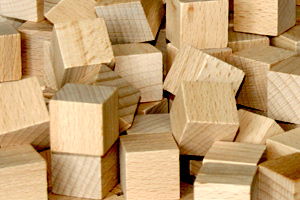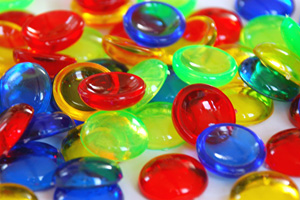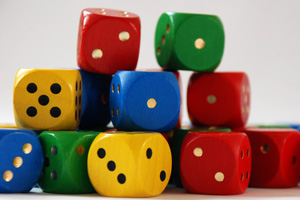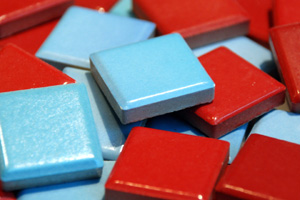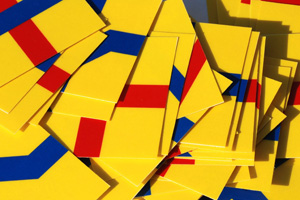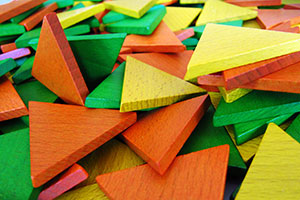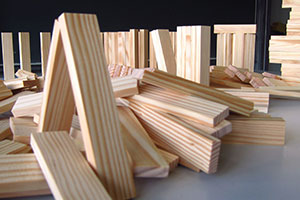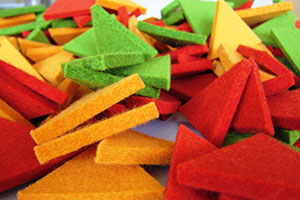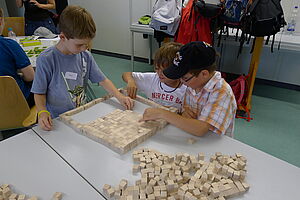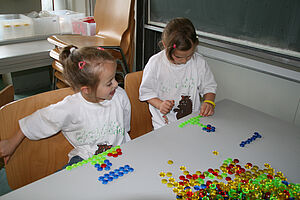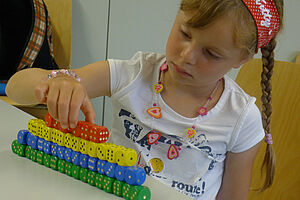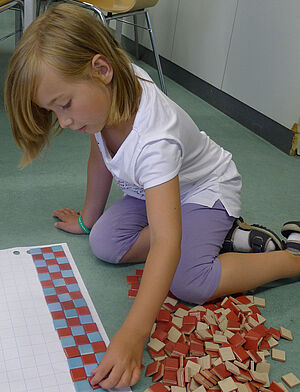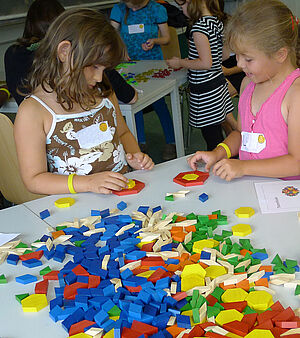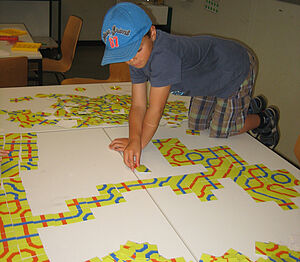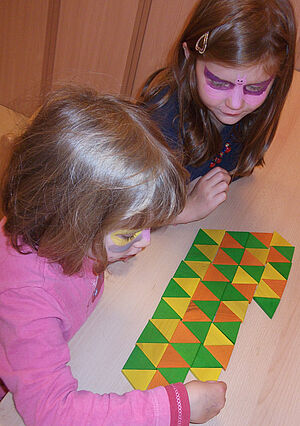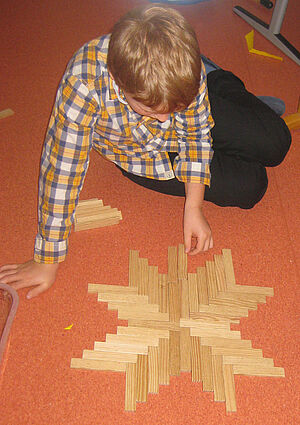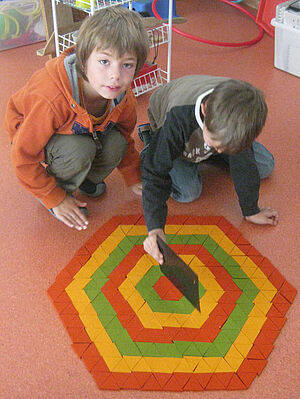Wooden Cubes
These are plain wooden cubes with equal edges measuring two centimeters.
These wooden cubes are particularly suitable for building three-dimensional objects. These objects often exhibit geometric structures such as symmetrical forms which can either be graphic or abstract. In addition the cubes can be used to illustrate and discover arithmetic relationships through geometric formations.
Mugglestones
These are colourful, circular, semi-transparent plastic beads, so-called Mugglestones, in the colours red, yellow, green and blue.
The combination of material, shape and colour result in Mugglestones having a high tactile appeal. On the one hand they encourage sorting and counting, but they are also suitable for creating graphic pictures or abstract designs.
The resulting arrangements in many cases show geometric structures (such as symmetries or displacements). Furthermore, with the help of the Mugglestones fundamental arithmetic principles based on geometric structures, can be illustrated and discovered.
Coloured Dice
These are standard six-sided dice in the colours red, yellow, green and blue.
The additional characteristics of colour and numbers enable an increased possibility of uses in comparison to the wooden cubes. The coloured dices not only encourage constructing three-dimensionally and two-dimensionally, but also sorting and counting. When using the dice it is possible to consider the colour and/or the numbers, or alternatively neither of these features.
Tiles
These are square mosaic tiles in the colours blue and red with an edge length of just 2.5 centimeters.
Due to the square shape and the reduction to two colours the tiles are very suitable for creating patterns – especially for friezes and mosaics. Checkered flip chart paper can be made available to use as an underlay as long as the size of the grid squares corresponds to the size of the tiles. If such a background is provided it gives an orientation for laying patterns but it can also be limiting as any variation in laying the tiles would break the given grid.
Patternblocks
These are small pieces of wood in five different geometric shapes:
- equilateral triangle (green)
- square (orange)
- two different diamonds (blue, natural)
- symmetrical trapezium (red)
- equilateral hexagon (yellow)
With the exception of the symmetrical trapezium, all the edges of the blocks are of equal lengths. These equal edges and suitably chosen angles lead to further relations between the shapes:
- Three green triangles can form the shape of a red trapezium.
- Two red trapeziums form a yellow hexagon.
- One blue diamond is the same as two green triangles.
- Three blue diamonds can be formed into the same shape as a yellow hexagon.
The Patternblocks lend themselves especially for the creating of two-dimensional patterns (circular, friezes, mosaics, parquetry).
Track Puzzle
These are square cards. Two tracks are depicted on each card.
There are four different track directions; however both tracks on each card will follow the same route. Each track can either be blue or red. This means that there are 12 different cards. It is possible to lay the Track Puzzle pieces next to each other in such a way that the red lines and the blue lines always follow on from each other. A large area can be “mapped - out” in this way. Equally a different pattern can be created (Eg. only using pieces with right angled tracks, all one colour, or only diagonal tracks).
Wooden Triangles
These are equilateral wooden triangles, with sides measuring 5 centimeters. They are in three different colours: yellow, orange and green.
Due to their equilateral characteristic, and the fact that three colours are available, these triangles are particularly suitable for creating and continuing a variety of patterns. These can take the form of friezes or parquetry. In the course of using these materials the children often attempt to balance the triangles on their edges. This challenges and encourages their dexterity and increases the possibility for creating patterns.
Kapla Blocks
These are oblong-shaped pieces of spruce wood, measuring 12 x 2.4 x 0.8 centimeters.
These simple kapla blocks encourage building three-dimensional objects such as castles. These often demonstrate various symmetries, but can also initiate non-mathematical activities such as role-plays. Kapla blocks are often used to build towers. This can lead to searching for the highest construction in the classroom or Kindergarten and can be a good introduction into the principles of height and size.
Kapla blocks encourage creating patterns on one plane in a variety of ways for example a herringbone parquetry.
Felt Triangles
These are equilateral triangles made out of felt with edges measuring 5 cm. They are in three different colours: orange, red and green.
Because of the material they are made out of, these triangles have a high tactile appeal. Their equilateral form makes them particularly suitable for creating friezes and parquetry. The resulting creations are often an example of axis and/or rotational symmetry.
